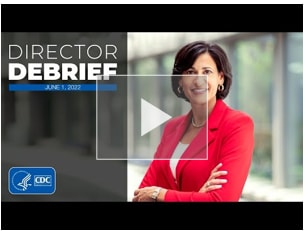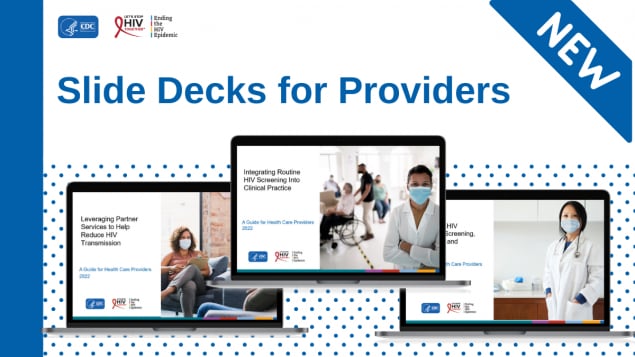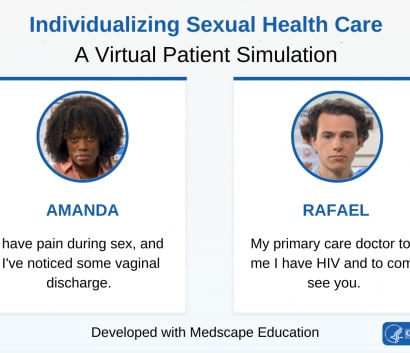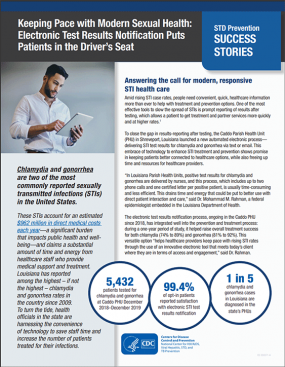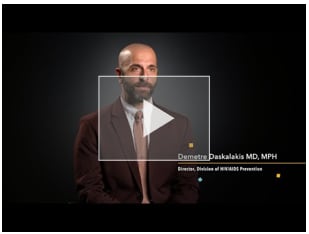Connections (May-June 2022)
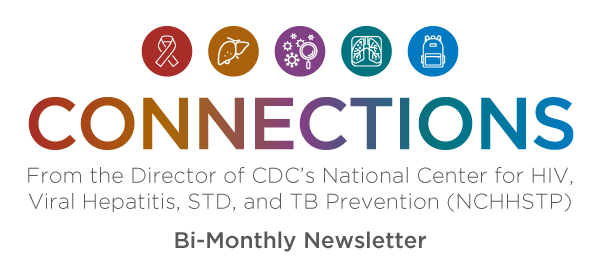
May – June 2022
From the Director - Jonathan Mermin, MD, MPH
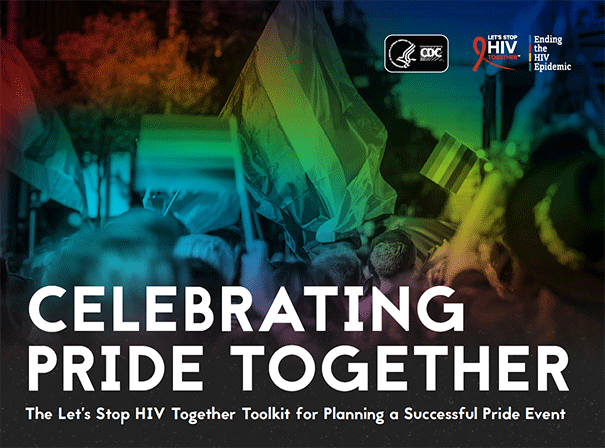
Dear Colleagues:
June is LGBTQ+ Pride Month! Please join me and millions of others in celebrating Pride and promoting equality for sexual and gender minority persons.
This year, the Let’s Stop HIV Together campaign has created a “how to” guide, the Together Pride-In-A-Box. It contains information and resources for those planning to hold in-person or virtual activities during Pride season. Pride events are full of opportunities to engage with the LGBTQ+ community and share important messages to reduce HIV stigma and address testing, prevention, and treatment.
Data analysis from our HIV surveillance reports offers us and our partners the ability to monitor trends, identify risk factors among priority populations/geographic areas, and monitor access to medical care and care-related outcomes. On May 24, 2022 we published a new HIV surveillance report: Diagnoses of HIV Infection in the United States and Dependent Areas, 2020 and a new HIV supplemental surveillance report: Monitoring Selected National HIV Prevention and Care Objectives by Using HIV Surveillance Data, United States and 6 Dependent Areas, 2020.
The COVID-19 pandemic in the United States led to disruptions in HIV testing services and access to clinical services throughout 2020. This disruption resulted in a steep, single-year decline in HIV diagnoses. Given these disruptions, data for 2020 should be interpreted with caution. You can learn more by reading Dr. Daskalakis’s and my recent letter:
- The overall number of HIV diagnoses in the United States in 2020 (30,403) was 17% lower than in 2019.
- HIV diagnosis percentages and rates were highest among gay, bisexual, and other men who have sex with men; persons aged 25–34 years; Black/African American persons; and persons residing in the South.
- From the perspective of racial and ethnic disparities, both absolute and relative disparities in HIV diagnoses were largest between Black/African American and White persons aged 13–24 years.
- Approximately 82% of people with HIV diagnosed during 2020 were linked to care within one month of diagnosis.
- Among all persons with diagnosed HIV in the areas, 65% had viral suppression.
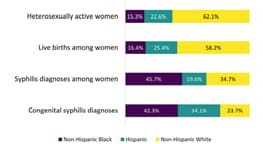
Figure 1: Comparison of the racial and ethnic distribution of heterosexually active women, live births, P&S syphilis, and congenital syphilis in the United States, 2014–2018.
From 2015–2019, syphilis rates among women and congenital syphilis increased substantially. A recent study highlights disparities in primary and secondary (P&S) syphilis rates among heterosexually active women by race/ethnicity, region, and age group. P&S syphilis diagnosis rates were higher among Black and Hispanic women than among White women, and the highest diagnosis rates and disparities were among younger women (18–29). With racial and ethnic disparities found across age groups and regions, the authors call for tailored local interventions for different age groups to improve health equity.
Summary Sources
- Martin EG, Ansari B, Rosenberg ES, Hart-Malloy R, Smith D, Bernstein KT, Chesson HW, Delaney K, Trigg M, Gift TL. Variation in patterns of racial and ethnic disparities in primary and secondary syphilis diagnosis rates among heterosexually active women by region and age group in the United States. Sex Transm Dis 2022;49(5):330–7.
- Sexually Transmitted Infections National Strategic Plan for the United States: 2021–2025
Monkeypox Response
CDC continues to closely track clusters of monkeypox that have been recently reported in several countries and the United States that do not normally have monkeypox activity. Efforts to investigate the source of transmission and identify contacts are ongoing. We suspect close personal contact is driving transmission. CDC is working with state and local health officials to identify people who may have been in contact with the people who have tested positive, so those contacts can monitor their health and seek care if they develop symptoms. Get the facts today from our CDC director, Dr. Walensky.
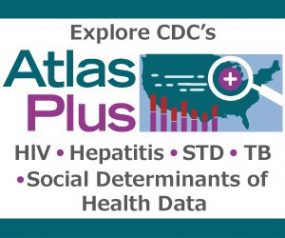
CDC’s AtlasPlus
What’s New in CDC’s AtlasPlus:
- New 2020 data on TB diagnoses at the national, state, and county-level
- Updated nine HIV indicators including 2020 data for all nice indicators and preliminary 2021 HIV diagnoses and linkage to care at the national, state and county-level. Data are based on cases reported to CDC through December 2021.
- National-level data by gender for the HIV diagnoses, linkage to care, receipt of HIV medical care, and HIV viral suppression.
- New national-level data for AIDS diagnoses, deaths, and prevalence now available for 1985-1999.
- Updating 2020 and preliminary 2021 data through June 2021 on PrEP coverage at the national, state, and county-level.
Fact Sheets on Health Education Curriculum Analysis Tool (HECAT)
CDC recently released a series of fact sheets on its Health Education Curriculum Analysis Tool (HECAT). The HECAT is an assessment tool that helps school districts and educators analyze their health education curricula. The fact sheets provide an overview and rationale for the HECAT, detail how to use the online tool to develop a health education scope and sequence, and how to analyze curricula.
Gaining Support for Community Syringe Service Programs (SSPs)
CDC released a new communication resource for Syringe Service Program (SSPs). The SSP communication toolkit “Gaining Support for Community Syringe Service Programs (SSPs)” is located at the National Harm Reduction Technical Assistance Center.
The communication toolkit helps communities looking to establish or enhance an SSP deliver effective messages that inform and educate law enforcement members and community leaders about the benefits of SSPs. The toolkit contains collateral materials and template SSPs that can use in their communities. These include SSP Fact Sheets, SSP Talking Points, SSP PowerPoint Training Deck, social media messaging and PDFs of all materials.
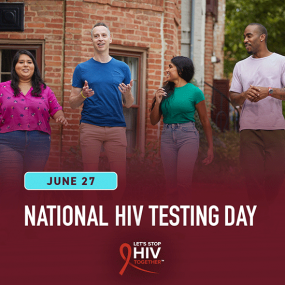
HIV Testing is Self-Care
On June 27th each year, we observe National HIV Testing Day (NHTD), a day to emphasize and encourage HIV testing. Our letter discusses this year’s theme “HIV Testing is Self-care.” HIV testing can be free, easy, fast, and confidential. HIV self-tests can be done in any convenient place, including one’s home .
HIV Screening, Prevention, Treatment & Care Slide Decks Now Available for download on CDC’s HIV Nexus
CDC developed several slide decks as additional resources for health care providers. These slide decks are to inform the delivery of HIV-related health care and support health care providers in communicating about HIV prevention and care to their patients.
Medscape Sexual Health Continuing Education Simulation
CDC launched a new continuing medical education opportunity – Individualizing Sexual Health Care: A Virtual Patient Simulation on Medscape. This program enhances clinical skills through engagement with patients in an objective and realistic interactive simulation that treats patients, diagnoses medical conditions, prescribes medications, and provides instant expert feedback on decisions.
Keeping Pace with Modern Sexual Health: Electronic Test Results Notification Puts Patients in the Driver’s Seat
The Caddo Parish Health Unit (PHU), a community and preventive health program in the Louisiana Department of Health answers the call for modern, responsive STI healthcare. PHU uses a new automated electronic notification system, which allows patients to access their STI test results for chlamydia and gonorrhea via text or email.
NEW Think. Test. Treat TB Campaign Resources and Education Materials
CDC developed a new Campaign Resource Overview as a guide to Think. Test. Treat TB materials. Think. Test. Treat TB education materials are also available in Spanish, Tagalog, Chinese, Ilocano, and Marshallese (in addition to English and Vietnamese). Materials are available to download from the campaign website, or order free of charge for via CDC-Info On Demand Publications (see ordering instructions). Check out all the campaign materials and resources.
PrEP Clinical Practice Guidelines
If you have questions about the new HIV PrEP clinical practice guidelines, my recent Medspace article gives a clear explanation.
New Social Determinants of Health (SDOH) videos
Five CDC leaders sat down to discuss their strategies to address Social Determinants of Health. The first two in the five-video series are from CDC NCHHSTP’s Deputy Director, Deron Burton, MD, JD, MPH, and CDC NCHHSTP’s Division of HIV Prevention Director (DHP), Dr. Demetre Daskalakis, MD, MPH. Both share their personal commitment to achieving health equity with a focus on the diseases and infections we work so hard to prevent.
CDC published 2020 data confirming setbacks in HIV prevention during the first year of the COVID-19 pandemic, including decreased HIV testing and minimal increases in pre-exposure prophylaxis (PrEP) prescriptions. Innovation and resolve steadied some outcomes, such as viral suppression, but were not enough to offset severity of pandemic-related disruptions. Efforts to protect health and meet rapidly approaching national goals to end the HIV epidemic must be accelerated.
Based on news media outreach efforts and recent coverage of the HIV data reports, CDC’s’s news media team is sharing the following articles:
- CDC Report: COVID Disrupted Efforts to End HIV – Politico Pro
- Pandemic Disrupted HIV Prevention Efforts, CDC Report Says – The Hill
- Steep but Deceptive Drop in HIV Diagnoses in 2020 – POZ
- Report Finds Worrisome Drop in HIV Diagnoses – Kaiser Health News
Additionally, the news media team recently updated its media backgrounder on HIV and Hispanic and Latino people in the U.S.
To get the latest news and announcements from our Center, check out the NCHHSTP newsroom.
Dr. Jonathan Mermin
@DrMerminCDC
- May: Hepatitis Awareness Month
- June 7: William (Bill) Jenkins Health Equity Lecture
- June 27: National HIV Testing Day
- March 10: National Women and Girls HIV/AIDS Awareness Day
- March 20: National Native HIV/AIDS Awareness Day
- March 24: World TB Day
- April 10: National Youth HIV/AIDS Awareness Day
- April 18: National Transgender HIV Testing Day

Mary Cashin
Do you have feedback, story ideas, content you would like to see in the newsletter? Contact us
Get Connections. Your more interesting inbox awaits!
Subscribe now
Mary Cashin
Do you have feedback, story ideas, content you would like to see in the newsletter? Contact us
Get Connections in your inbox
